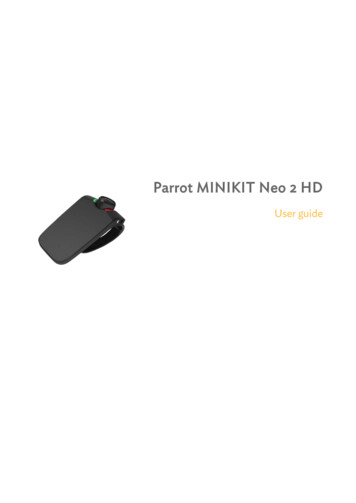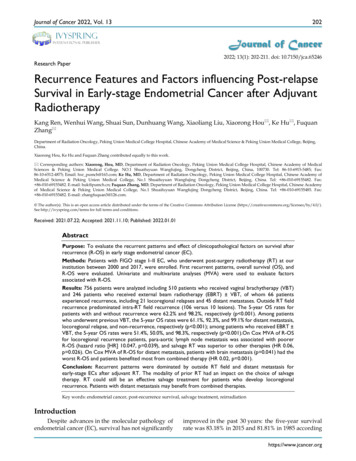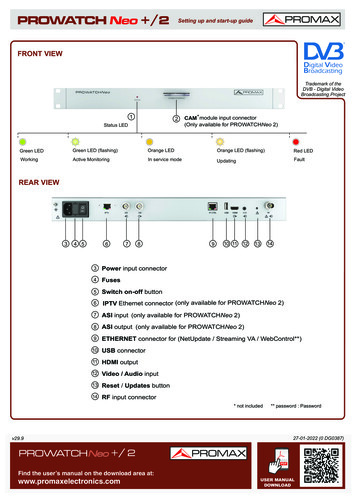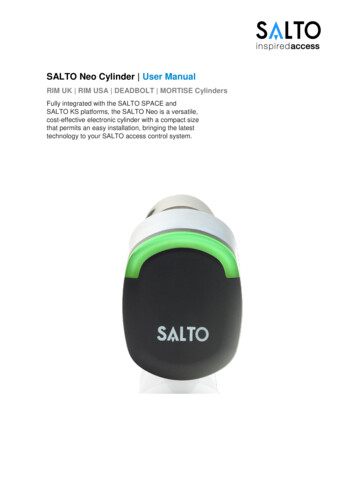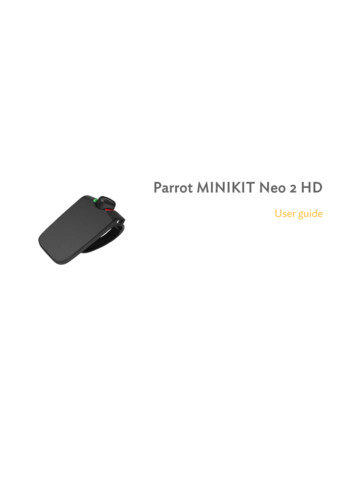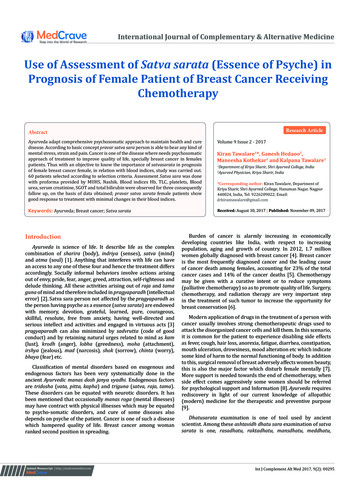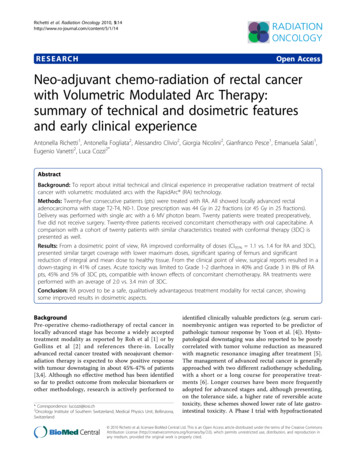
Transcription
Richetti et al. Radiation Oncology 2010, CHOpen AccessNeo-adjuvant chemo-radiation of rectal cancerwith Volumetric Modulated Arc Therapy:summary of technical and dosimetric featuresand early clinical experienceAntonella Richetti1, Antonella Fogliata2, Alessandro Clivio2, Giorgia Nicolini2, Gianfranco Pesce1, Emanuela Salati1,Eugenio Vanetti2, Luca Cozzi2*AbstractBackground: To report about initial technical and clinical experience in preoperative radiation treatment of rectalcancer with volumetric modulated arcs with the RapidArc (RA) technology.Methods: Twenty-five consecutive patients (pts) were treated with RA. All showed locally advanced rectaladenocarcinoma with stage T2-T4, N0-1. Dose prescription was 44 Gy in 22 fractions (or 45 Gy in 25 fractions).Delivery was performed with single arc with a 6 MV photon beam. Twenty patients were treated preoperatively,five did not receive surgery. Twenty-three patients received concomitant chemotherapy with oral capecitabine. Acomparison with a cohort of twenty patients with similar characteristics treated with conformal therapy (3DC) ispresented as well.Results: From a dosimetric point of view, RA improved conformality of doses (CI95% 1.1 vs. 1.4 for RA and 3DC),presented similar target coverage with lower maximum doses, significant sparing of femurs and significantreduction of integral and mean dose to healthy tissue. From the clinical point of view, surgical reports resulted in adown-staging in 41% of cases. Acute toxicity was limited to Grade 1-2 diarrhoea in 40% and Grade 3 in 8% of RApts, 45% and 5% of 3DC pts, compatible with known effects of concomitant chemotherapy. RA treatments wereperformed with an average of 2.0 vs. 3.4 min of 3DC.Conclusion: RA proved to be a safe, qualitatively advantageous treatment modality for rectal cancer, showingsome improved results in dosimetric aspects.BackgroundPre-operative chemo-radiotherapy of rectal cancer inlocally advanced stage has become a widely acceptedtreatment modality as reported by Roh et al [1] or byGollins et al [2] and references there-in. Locallyadvanced rectal cancer treated with neoajuvant chemoradiation therapy is expected to show positive responsewith tumour downstaging in about 45%-47% of patients[3,4]. Although no effective method has been identifiedso far to predict outcome from molecular biomarkers orother methodology, research is actively performed to* Correspondence: lucozzi@iosi.ch2Oncology Institute of Southern Switzerland, Medical Physics Unit, Bellinzona,Switzerlandidentified clinically valuable predictors (e.g. serum carinoembryonic antigen was reported to be predictor ofpathologic tumour response by Yoon et al. [4]). Hystopatological downstaging was also reported to be poorlycorrelated with tumor volume reduction as measuredwith magnetic resonance imaging after treatment [5].The management of advanced rectal cancer is generallyapproached with two different radiotherapy scheduling,with a short or a long course for preoperative treatments [6]. Longer courses have been more frequentlyadopted for advanced stages and, although presenting,on the tolerance side, a higher rate of reversible acutetoxicity, these schemes showed lower rate of late gastrointestinal toxicity. A Phase I trial with hypofractionated 2010 Richetti et al; licensee BioMed Central Ltd. This is an Open Access article distributed under the terms of the Creative CommonsAttribution License (http://creativecommons.org/licenses/by/2.0), which permits unrestricted use, distribution, and reproduction inany medium, provided the original work is properly cited.
Richetti et al. Radiation Oncology 2010, ity-modulated radiotherapy and simultaneousboost in association with capecitabine chemotherapywas reported as unacceptably toxic and was interrupted[7] questioning at the same time the role of advancedtreatment modalities like intensity modulation and theapplication of alterated fractionations to locallyadvanced rectal cancer.In summary, the current challenge is to improve outcomes whereas minimizing morbidity and maximizingthe potential for more complete surgery resection andsphincter preservation.Aim of the present study is to report the technical anddosimetric aspects of the treatments as well as to summarize early acute toxicity findings and histo-pathological results after surgery. The introduction of anadvanced technology as volumetric modulated arc therapy in clinical practice follows the hypothesis that thisshall lead to dosimetric and clinical results not inferiorand possibly superior to previous treatment modalities.For this reason, to prove the hypothesis at a basic level,as a first approach to the new treatment modality, thefirst group of patients treated with this new modality atour institute, was planned with the same planning objectives of the previously adopted conformal modality, inorder to demonstrate at least the clinical equivalence ofthe new approach with conformal data, and to possiblygive information about the potential improvements ontoxicity rates or on logistic side. To enable a qualitativecomparison of the treatment features and early outcome, a group of patients with similar characteristicsbut irradiated with a 3D conformal technique, waspooled out of the institutional database and analysed inparallel. A similar investigaton was performed at planning level by Engels et al [8] comparing HelicalTomotherapy and 3D-conformal plans showing that thecombination of helical tomotherapy and in their casethe usage of daily adaped margins based on MV-CTimaging significantly decreases the probability of gastrointestinal toxicity. Consistently, a study from the William Beaumont Hospital group [9] showed a clear andhighly significant dose-volume relationship betweenbowel irradiation and acute grade 3 diarrhoea suggestingthe need of reducing as much as possible the involvement of the relatively distant organ at risk during preoperative irradiation of rectal cancer. Similar resultswere reported by Tho et al. [10] from University ofGlasgow showing a strong dose-volume relationshipwith acute diarrhoea at all dose levels. These resultsshow that, although 3D conformal treatments are technically adequate for pre-operative rectal cancer patients,the application of advanced techniques shall be carefullyexplored being potentially beneficial for the patients.The Volumetric Modulated Arc Therapy techniqueadopted for this study is RapidArc (RA), the technicalPage 2 of 9solution realised by Varian Medical Systems (Palo Alto,California) and based on the original investigation of K.Otto [11].RapidArc was recently introduced in clinical practicein several institutes after an intensive validation at planning level where it was compared to IMRT or otherapproaches, in a series of studies on brain tumours,prostate, head and neck, anal canal, cervix uteri andother indications [12-18]. At our institute, as per end ofSeptember 2009, 160 patients have been treated withRA for a variety of indications. Among these, twentyfive received RA treatment as part of their multidisciplinary management of rectal adenocarcinoma, most ofthem in pre-operative neo-adjuvant chemo-radiation setting. RA is implemented at planning level by means ofthe Progressive Resolution Optimisation (PRO) algorithm in the Eclipse planning system by Varian. Theoptimisation process is based on an iterative inverseplanning process aiming to simultaneously optimise theinstantaneous multi leaf collimator (MLC) positions, thedose rate, and the gantry rotation speed to achievethe desired dose distribution. Delivery is performed onVarian Clinacs as single or multiple arcs with dynamiccontinuous modulation of MLC shapes, gantry speedand dose rate.Materials and patientsTwenty-five consecutive patients presenting advancedrectal carcinoma were treated with RA from October2008 to September 2009. A corresponding group oftwenty patients, treated with 3D conformal therapy(3DC) during the years 2007 and 2008 was used as abenchmark; these patients were randomly pooled out ofthe institutional database. Comparison was performedagainst 3DC technique since this was the treatmentmodality in use for rectal patients before advent of volumetric modulated arc therapy at our institute. Randomselection was performed from the entire group of rectalcarcinoma patients restricting the selection to the sameprescription, fractionation and combined chemotherapyregimen and to reproduce a reasonably similar group.The comparison with 3D conformal data was introducedto allow a qualitative appraisal of the consistency of RAbased treatments with previous clinical experience inthe same clinic without aiming to perform any equivalence study and without aiming to perform a matchedpair analysis. Demographic and clinical characteristics ofpatients are summarized in table 1. Most of the patientswere treated pre-operatively in a neo-adjuvant schedulewith chemotherapy concomitant to radiation. Oral capecitabine was administered with standard dosage of 825mg/mq twice a day. Four patients in the RA group weretreated post-operatively and one did not receive surgeryfor patient’s choice. Dominant stage was T3, N0-N1 and
Richetti et al. Radiation Oncology 2010, 5:14http://www.ro-journal.com/content/5/1/14Page 3 of 9the main differentiation grade was G2. Median age wassimilar between the two groups (65.4 and 63.5 yearsrespectively for RA and 3DC).Gross Target Volume (GTV) was defined as thetumour and involved nodes visible to CT/MRI images.Clinical Target Volume (CTV) included the GTV with 1cm isotropic margin and the pelvic lymph nodes thatwere not involved (peri-rectal, presacral, obturator,internal iliac). Planning target volume (PTV) wasdefined as the CTV with a margin of 8 mm. Organs atrisk routinely considered in these patients were bladder,femoral heads and bowels (peritoneal region includingsmall- and large- bowels excluding PTV). In addition, asdefined for all patients treated with intensity modulatedmodalities, the Healthy Tissue (HT) was additionallydefined as the patient’s volume included in the CTTable 1 Summary of patients characteristics at treatmentstart.RA3DCNumber ofpatients2520Males76% (19/25)65% (13/20)Females24% (6/25)35% (7/20)Age [years](median andrange)65.4 [37, 85]63.5 [46, 79]HystologyAdenocaAdenoca0% (0/25)84% (21/25)15% (3/20)75% (15/20)Stage TT2T3T416% (4/25)10% (2/20)Stage NN048% (12/25)40% (8/20)N144% (11/25)35% (7/20)N24% (1/25)10% (2/20)Nx4% (1/25)15% (3/20)M096% (24/25)95% (19/20)M14% (1/25)5% (1/20)Stage MGrade GLocationChemotherapyG14% (1/25)10% 2/20)G284% (21/25)90% (18/20)G312% (3/25)0% (0/20)Low48% (12/25)15% (3/20)Medium16% (4/25)45% (9/20)High36% (9/25)40% (8/20)CapecitabinNo chemio92% (23/25)8% (2/25)100% (20/20)0% (0/20)Pre-op80% (20/25)90% (18/20)Post-op16% (4/25)10% (2/20)Non-op4% (1/25)0% (0/20)Radiation Dose44 Gy/22 fractions72% (18/25)80% (16/20)Prescription45 Gy/25 fractions20% (5/25)20% (4/20)Radiation Boost40 Gy/20 fractions50.4 Gy8% (2/25)12% (3/25)0% (0/20)25% (5/20)Dose Prescription54.0 Gy4% (1/25)0% (0/20)SurgeryValues are expressed in number of patients when not otherwise specified.dataset minus the PTV volume. This healthy tissuevolume was generated also for the benchmark group ofpatients. Volumes are reported in the results section.Dose prescription was set to either 44 Gy in 2 Gy/fractions or 45 Gy in 1.8 Gy/fractions for the majority of thecases (only 2 patients received 40 Gy in 2 Gy fractions inthe RA group). Four (five) patients in the RA (3DC) groupreceived also a final boost to 50.4 Gy (54 Gy in one case)being either post-operative or non operable cases. In allRA cases, dose normalization was set to mean dose toplanning target volume (PTV) while for 3DC plans, dosenormalization was set to isocentre, according to currentand forthcoming ICRU recommendations.RA plans were optimised for single arcs (rotation of358 , from 179 to 181 CCW) for a Clinac 2100iXequipped with a Millennium-120 MLC (120 leaves witha resolution at isocentre of 5 mm for the inner 20 cmand 10 mm for the outer 2 10 cm) and a beam energyof 6 MV. Further details on RA technique can be foundin [13,14]. Plan optimisation was performed requiring aPTV coverage of 95%-107%. Concerning OARs, bladdermean dose was required to be inferior to 35 Gy and V40Gy 50%. Maximum dose to femurs was notconstrained.3DC plans were designed, according to institutionalpractice, with three fields (one posterior and two laterals) with mechanical wedges on the lateral beams.Conformal shaping of the fields was performed bymeans of static MLC. Plans were computed for a Clinac2100EX equipped with a MLC-80 (80 leaves with a resolution at isocentre of 10 mm) and for a beam energy ofeither 6 MV or 15 MV.All dose distributions were computed with the Analytical Anisotropic Algorithm (AAA) implemented in theEclipse planning system with a calculation grid resolution of 2.5 mm.Technical features of treatments have been reported interms of main delivery parameters (number of field orarcs, field or control point size, MU, MU/deg and MU/Gy, Dose Rate, Gantry speed, Collimator angle, beam-onand treatment time); beam-on and treatment times aredefined without inclusion of patient positioning andimaging procedures and were automatically scored bythe record and verify electronic system and derived offline from the database for this analysis. Beam on timeincludes only the time needed to deliver the requiredMU summed on all involved fields while treatment timeincludes machine set-up and programming time andtime needed to move from one field to the next and tomount the mechanical wedges (for the 3DC technique).For RA, beam on time, with conventional fractionation,is bound to maximum angular speed of the gantrywhich is limited to 4.8 /sec; dose rate does not play arole in this case.
Richetti et al. Radiation Oncology 2010, 5:14http://www.ro-journal.com/content/5/1/14For RA patients, results of pre-treatment plan quality assurance are reported as Gamma AgreementIndex (GAI), i.e. the percentage of modulated fieldarea passing the g-index criteria of Low [19] withthresholds on dose difference set to ΔD 3% of thesignificant maximum dose, and on Distance to Agreement set to DTA 3 mm. Measurements and analysiswere performed by means of the GLAaS methodologydescribed in [20,21] based on absorbed dose to waterfrom EPID measurements. 3DC plans were not subjectto pre-treatment dosimetric verification as normalpractice for all non intensity modulated treatments,routine MU verification was performed on thesepatients.Dosimetric quality of treatments was measured fromdose volume histogram (DVH) analysis. For PTV the following data were reported: target coverage (D1%, D99%,V 95% , V 107% ), homogeneity (D 5-95% ) and conformity(CI90% and CI95%). CI was defined as the ratio betweenthe volume of patient irradiated at 95% (90%) of the prescribed dose and the PTV volume. For OARs, the meandose, the maximum dose (D1%) and appropriate values ofVxGy (volume receiving at least Gy) were scored. ForHealthy Tissue, the integral dose (DoseInt) was reportedas well. This is measured as the integral of the dose delivered to the entire HT and is expressed in Gy cm3.Wilcoxon non-parametric two-sample tests wereapplied to compute significance of observed dosimetricdifferences for the various parameters.Page 4 of 9Clinical outcome of treatments was recorded in termsof observed acute toxicity, particularly incidence of disuria and diarrhoea. Toxicity scoring was assessed bynon blind radiation oncologists in charge of the variouspatients and according to the National Cancer InstituteCommon Terminology Criteria of Adverse Effects scale(CTCAE version 3) as part of the routine visits duringtreatment and follow up protocols. At the time of surgery, histo-pathological reassessment of the tumourstage was performed. For the patients having this information available in the institutional database, the stagingchangement of the diseases was recorded, comparingdata at surgery with data at diagnosis. Staging at diagnosis was assessed by means of standard diagnostic procedures including CT and MR imaging and clinicalexamination of patients.ResultsFigure 1 shows examples of dose distributions for twopatients treated with RA or with 3DC plans. Colourwashis in the interval from 10 to 47 Gy. PTV, femurs and bladder are outlined as solid lines in the images. Figures 2 and3 report the average dose volume histograms of the twogroups of patients for PTV, bladder, bowels, femurs andhealthy tissue. Dashed lines represent the inter-patientvariability at one standard deviation.Table 2 summarises the technical features of the treatment characteristics. Table 3 reports results of the DVHanalysis for the primary course of 44/45 Gy. Tables 4 andFigure 1 Isodose distributions for two example patients for RA and 3DC treatments for an axial plane, sagittal and coronal views.Doses are shown in colorwash within the interval from 10 to 47 Gy. PTV, bladder and femurs are outlined.
Richetti et al. Radiation Oncology 2010, 5:14http://www.ro-journal.com/content/5/1/14Figure 2 Average Dose Volume Histograms for PTV for RA and3DC plans. Dashed lines represent inter-patient variability at 1standard deviation.Page 5 of 95 record the clinical data of the treatments as early acutereactions and surgical outcome whenever available.From technical features, it is evident how pure beamon time for RA is slightly longer than the correspondingquantity for 3DC but this difference is compensated bythe usage of single arc against the usage of multiple static fields with wedges (normally mechanical beingoriented in left-right direction and no collimator rotation is applied to keep MLC leaves in the needed direction to generate conformal shapes). This means that a3DC plan requires a substantially longer time to bedelivered. Higher monitor units were observed for 3DCplans because of the usage of wedges. Fixed dose rate of300 MU/min was selected for 3DC treatments frominstitutional policy for conventional treatments, whilethe effective average dose rate for RA plans resulted of 200 MU/min, associated to a constant maximum gantry speed rotation (dose rate does not affect deliverytime for RapidArc as mentioned in the methods). Fieldsize, defined by jaws, resulted larger for RA but, considering the effective aperture size of the continuouslyFigure 3 Average Dose Volume Histograms for Bladder, Bowel, Femurs and Healthy Tissue for RA and 3DC plans. Dashed linesrepresent inter-patient variability at 1 standard deviation.
Richetti et al. Radiation Oncology 2010, 5:14http://www.ro-journal.com/content/5/1/14Page 6 of 9Table 2 Technical characteristics of RapidArc andconventional plansTable 3 Summary of DVH analysis for PTV, Bladder,Femurs, Bowels and healhty tissue.RA3DCNumber of arcs or fields1 (25/25)3 (15/20), 4 (5/20)RA3DCPArc length [ ]358 0.0NAVolume [cm3]1360 2501358 2180.98Beam energyBeam on time [min]6 MV (25/25)1.24 0.06 MV (7/20) 15 MV (13/20)0.98 0.2Mean [Gy]D1% [Gy]43.9 1.346.1 1.544.0 1.046.3 1.40.870.65Treatment Time [min]2.05 0.093.42 0.25D5-95% [Gy]3.5 0.84.0 0.90.10MU276 32293 46D99% [Gy]41.0 1.340.9 0.90.750.14PTVMU/Gy141 14149 21V95% [%]96.5 2.795.3 2.5MU/deg0.8 0.1NAV107% [%]0.2 0.41.0 2.10.07Dose Rate [MU/min]222 25300CI90%1.2 0.11.6 0.1 0.01Gantry speed [deg/sec]4.8 0.0NACI95%1.1 0.11.4 0.1 0.01Collimator angle [ ]Mean CP area [cm2]24 8156 280 0NAVolume [cm3]190 166Bladder98.0 360.022Mean field area [cm ]393 75249 32Mean [Gy]34.0 4.232.7 7.10.45GAI [%]98.33 1.17NA68.2 38.446.5 26.40.11V40Gy[cm3]BowelsMU: monitor units, CP: control pointadapting control points (elementary apertures), thesituation is reversed with RA resulting in smaller average apertures compared to 3DC.Pre-treatment quality assurances of RA plans resultedin an average gamma agreement index GAI 3% superiorto the acceptance threshold of 95% (range: 95.4 - 99.9%),set as references in our institute.Dosimetric data showed that RA offered a significantimprovement in treatment conformality (CI 90% andCI95%) with a trend to significance (p 0.10) for homogeneity (D5-95%) and for V107%. No other significant differences between RA and 3DC have been observed. PTVvolumes were equivalent between the two groups. Concerning femurs, RA showed a significant reduction inboth mean and maximum dose. Bladder data, althougha significant difference in the organ’s volume wasobserved (not correlated to any change in patient preparation protocols), no statistically significant differenceswere observed, with RA delivering low doses to a largerrelative volume than 3DC. For bowels, RA presented asystematic additional sparing over the entire dose rangebut statistically significant only for the maximum significant dose D1%.Significant differences were instead observed forHealthy Tissue with RA showing a lower integral andmean dose.Concerning clinical outcome, only early results areavailable. Total treatment duration (including week endsand holidays) resulted in a similar number of days witha wider span for 3DC due to some unscheduled interruptions prolonging the course of treatment for thisgroup. The clinical data showed (Table 4) that, after surgery, a T down-staging was observed in 7 patients over17 with RA. For 3DC the T down-staging was observedVolume [cm3]3417.7 816.52609.0 718.1Mean [Gy]5.9 1.08.7 5.20.27D1% [Gy]31.4 4.037.8 3.80.03[%][%]2.1 2.60.4 0.8V30V36GyGy8.7 10.84.8 8.30.130.220.27FemursVolume [cm3]322.1 101.2315.4 74.30.81Mean [Gy]8.7 1.510.8 1.7 0.01D1% [Gy]39.8 1.943.9 1.3 0.01Healthy tissueVolume [cm3]24903 651821629 38380.05Mean [Gy]V10 Gy [%]8.7 1.535.5 6.610.8 1.735.8 6.0 0.010.89DoseInt2.1 0.52.3 0.3 0.01Dx% dose received by the x% of the volume; Vx% volume receiving atleast x% of the prescribed dose; CI ratio between the patient volumereceiving at least 95% of the prescribed dose and the volume of the totalPTV. DoseInt Integral dose, [Gy cm3 105]Data are relative to the primary course of 44/45 Gy only.Table 4 Clinical results after chemo-radiotherapy andsurgery.TNMDownstaging: (at surgery)Upstaging: (at surgery)RA3DC32 4 [25-39] 33 7 [28-56]Duration of RT [days] (for the44/45 Gy course)T41% (7/17)*26% (5/19)N12% (2/17)21% (4/19)T6% (1/17)11% (2/19)N18% (3/17)11% (2/19)M6% (1/17)0% (0/19)* 3 patients are lost to follow-upValues are reported in % of patients scored for the specific parameter and inbrackets the number of patients reporting an effect vs. the total scored).
Richetti et al. Radiation Oncology 2010, 5:14http://www.ro-journal.com/content/5/1/14Page 7 of 9Table 5 Early acute toxicity G1/G228%(7/25)15% (3/20)G3/G40% (0/25)0%(0/20)G1/G240% (10/25)45% (9/20)G3/G48% (2/25)5% (1/20)G1/G20% (0/25)10%(2/20)G3/G40%(0/25)0% (0/20)in 5 patients over 19. N down-staging was observed in2/17 patients in the RA group and 4/19 in the 3DCgroup of patients. Some up-staging for both T and Nwere observed in both RA and 3DC patients. Distantmetastasis progression was observed in one patient inthe RA group and in no patients in the 3DC group.Chemotherapy is one of the most challenging components of the treatment scheme and was interrupted in asimilar proportion of patients between the two groups(12% and 15% respectively) for toxicity. Similar patternsof acute toxicity were observed, as expected, betweenthe two groups. All patients in the 3DC group receivedchemotherapy while two patients did not received anychemotherapy in the RA group (8%, both post-operativepatients).Concerning quantitative results on acute toxicity(table 5), about 50% of patients showed diarrhoea up tograde 3 (G3 in the 8% of RA patients and 5% in the3DC patients). 28% of RA patients manifested localerithema of grade 1 or 2, 15% in the 3DC group ofpatients; no grade 3 erithema or higher were observed.Two patients in the 3DC group developed disuria/incontinency, none for RA.Discussion and conclusionsBased on the results of an intensive program of pre-clinical investigations performed at planning level [12-18] toassess its reliability and potential benefit, RA, a Volumetric Modulated Arc Therapy, was introduced in clinical practice since September 2008 at our institute for avariety of indications. The present study reports aboutthe early findings from the treatment of a group of 25patients affected by advanced rectal adenocarcinomairradiated with RA. Most of the patients received concomitant chemotherapy with capecitabine in a pre-operative neo-adjuvant scheme.The main objective of the first phase of clinical introduction of RA is the assessment of the possibility toadminister to patients treatments not inferior and possibly superior to previously adopted conventional modalities. These results should be achieved withoutintroducing elements of potential confusion like alterations of the fractionation schemes (acceleration or hypofractionation for example) or like the attempt tomaximise dosimetric performances (e.g. enhanced protection of organs at risk). Further studies will assess theelements of improvement once the safety of the newapproach is consolidated in routine practice.Under this perspective, RA showed, according to thehere presented data, the capability to reliably reproducethe dosimetric quality of conventional conformal plans,previously used as the standard of treatment for thisclass of patients, with some already observable improvement in i) conformality of treatments, ii) reduction ofhot spots inside target volume, iii) reduction of distantorgans at risk involvement like femurs or bowels, iv)global reduction of healthy tissue involvement. Althoughmost of the trends observed and reported in the tablesare minor, not statistically significant and likely notclinically relevant, the three points mentioned above(statistically significant) suggest how the advanced technique with volumetric modulation with arcs might bebeneficial and confirm general findings from in-silicoinvestigations [12-18]. The dosimetric improvementachieved with RA compared to 3DC is quite obviousand might be similar to what achievable with otherIMRT approaches. In our institute the selection of RAinstead of, e.g., fixed gantry IMRT was based also onlogistic issues as discussed below.These results enabled the activation of a second phase,aiming to push RA towards improved sparing of organsat risk, particularly the bladder and the bowels, asalready potentially proven in planning investigation forcervix uteri treatments [13].Having achieved the same quality of treatments ofpreviously adopted techniques, RA confirmed also someadvantages at a logistical level. It allowed a significantreduction of effective treatment time, defined as thetime needed to deliver a single fraction with the exclusion of time needed to position the patients and toacquire data for image guidance. The measured treatment time reduction with RA was about 40%. If theabsolute benefit is a reduction of about 1.4 minuteswhich seems to be limited, it shall be noted that thiswas obtained from a comparison against a 3DC technique rather than IMRT with fixed gantry fields. IMRTmight allow abetter dosimetric quality but at theexpense of prolonged treatment time. In addition, RAallows avoidance of usage of wedges. Mechanical wedgeswere used in our institute instead of dynamic wedges toallow useful orientation of them without conflictingwith MLC leaves movement, but this required manualoperation by radiographers with multiple entries into inthe treatment room. Therefore, the logistic benefitderived from RA is significant for a department andreduces also the risk of human error.From a more general perspective, optimization and calculation of RA plans is obviously a longer process than the
Richetti et al. Radiation Oncology 2010, d calculation of 3DC plans in most of the cases.Nevertheless, although the number of treatment machinesin a department cannot be easily increased, the planningpower of a radiotherapy facility is much more easily customizable and addition of more planning station, availabilityof faster hardware and distribution of calculation burdenover the planning network are all methods of ‘’adaptation”achievable at reasonable costs. Therefore, the longer timeobjectively needed for any IMRT planning process, particularly for RA, has a potentially smaller impact on theclinical throughput than the time-slots to be allocated perpatients at the treatment units.From the clinical point of view, data presented hereshow that RA can be considered as a safe modality forthis category of patients with a good potential forimproving OAR sparing and acute toxicity. On the clinical outcome, although interesting, it is possible that theobserved increased in down-staging is due to statisticalfluctuations from the very small group of patients. Intheory, having not introduced any fractionation alteration (like dose escalation) an improved downstaging isnot expected and should be investigated on larger samples. To notice anyway that the downstaging rateobserved for patients treated with RA is consistent withreported data [3]. The possibility of improving organs atrisk sparing shall be explored with RA in order to compensate or mitigate known negative effects from concomitant chemotherapy (e.g. reduction of diarrhoea). Thesmoother process of RA and its potential reduction inacute toxicity could also lead to a more uniform duration of treatments reducing the risk of unscheduled andundue interruptions.It is obvious that the present study cannot be considered as conclusive and that long term observation ofpatients is needed to measure outcome and late toxicity.These preliminary results are anyway encouraging forfurther experience i
Neo-adjuvant chemo-radiation of rectal cancer with Volumetric Modulated Arc Therapy: summary of technical and dosimetric features . down-staging in 41% of cases. Acute toxicity was limited to Grade 1-2 diarrhoea in 40% and Grade 3 in 8% of RA . of 2.0 vs. 3.4 min of 3DC. Conclusion: RA proved to be a safe, qualitatively advantageous .

